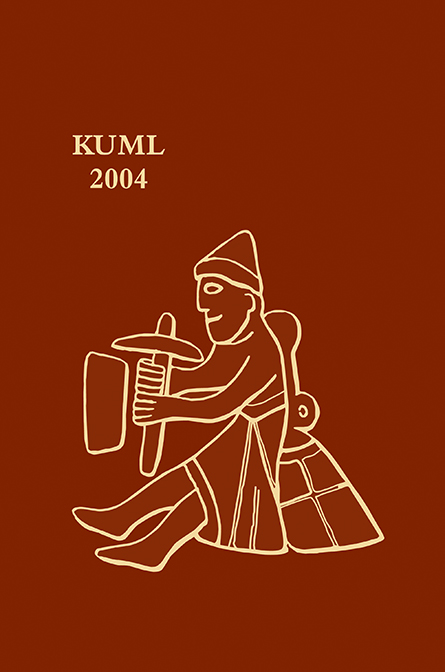Knud den Helliges ørnetæppe i Odense Domkirke – Et forsøg på en nytolkning
DOI:
https://doi.org/10.7146/kuml.v53i53.97501Nøgleord:
Knud den Hellige, ørnetæppe, Odense DomkirkeResumé
Saint Canute the King’s Eagle Cloth in Odense CathedralA new interpretation
The eagle silk cloth in Odense Cathedral (Fig. 1) is believed to have been part of the contents of the shrine of Saint Canute (King Canute the Holy); it was perhaps a cape used as a shroud. Today it measures 110 by 133 cm, but originally it was larger, at least 130 by 195 cm. The purple fabric with its blue-black eagle pattern and decoration is generally regarded as a “pannus imperialis ad aquilas magnas” – a term known from medieval texts. The style of its decorative motifs dates it to the 11th or 12th century. Otto von Falke regarded the Odense cloth and related fabrics as the products of the Byzantine state workshop. Agnes Geijer, on the other hand, assumed that the Odense specimen was made by Islamic weavers in Southern Italy or Sicily and that it had formed part of the gifts which Canute’s widow, who had later married Duke Roger of Apulia, sent to the saint’s shrine.
Underneath the eagle pattern on the cloth there seems to be an inscription (Fig. 2). Although only a few of the letters are legible the classical philologist Carsten Høeg considered them to be based on Greek letter-forms. It is in fact possible to distinguish at least five, and in addition, there are some possible ligatures of two or three letters (Fig. 3). A comparison between these vestiges and well-known Byzantine textile inscriptions leads to the impression that the last word could have been DESPOTOU, and that several of the preceding signs may be part of the word PHILOCHRISTOU. If so, we have an official dating, and even the name of the emperor in question. Among the rulers in the 11th and the 12th centuries, only five had a name short enough to fit into this context, and if we are right in distinguishing an alpha or a lambda in the beginning, this would exclude all but Alexios. Consequently, we will venture to make a hypothetic reconstruction with this name based on the existing remains (Fig. 4).
The style of the fabric makes it most unlikely that anyone else but Alexios I (1081-1118) could come into question. It was he, who – probably in 1103 – received Saint Canute’s brother, King Eric the Good (Erik Ejegod), who died that very same year in Cyprus on his way to the Holy Land. In Eiriksdrapa, the memorial poem written in honour of this king by the contemporary Icelandic bard, Markus Skeggjason, it is explicitly stated that among other rich gifts, Eric was presented with an imperial garment: “allvalds skruði”, i.e. “the emperor’s shroud”.
One of the present authors has drawn attention to the possibility that the bluish dark colour of the eagles indicates that the fabric was intended for a “sebastokrator,” a brother or son of the emperor or someone else very close to him. The colours, the eagles, and the size of the cloth would actually be appropriate for the type of garment called a “paludamentum”, a purple officer’s cloak worn by the emperor and other highly prominent persons (Figs. 5-6). Some of the leaders of the First Crusade were honoured by being elevated to the status of adopted sons of the emperor, and Krijnie Ciggaar has wondered whether the same could have happened to Eric. If this was the case, then it seems that it was Eric’s imperial silk cloth that was transferred to Odense as a tribute to his more distinguished brother, the martyr saint.
Recently, it has been stated that the red colour of the Odense cloth is not genuine purple. However, the loss of most of Anatolia and Lebanon made it difficult for Byzantine workers to obtain the right colour components. Genuine murex-purple was in fact used in Constantinople until the thirteenth century, but this top-quality purple was reserved for the emperor alone. This explains why an inferior dye quality was used for the Odense cloth, which was made for a person with the rank of a sebastokrator.
P.J. Riis
København
Thomas Riis
Christian-Albrechts-Universität zu Kiel
Downloads
Publiceret
2004-10-24
Citation/Eksport
Riis, P., & Riis, T. (2004). Knud den Helliges ørnetæppe i Odense Domkirke – Et forsøg på en nytolkning. Kuml, 53(53), 259–273. https://doi.org/10.7146/kuml.v53i53.97501
Nummer
Sektion
Artikler
Licens
Fra og med årgang 2022 er artikler udgivet i Kuml med en licens fra Creative Commons (CC BY-NC-SA 4.0).
Alle tidligere årgange af tidsskriftet er ikke udgivet med en licens fra Creative Commons.


